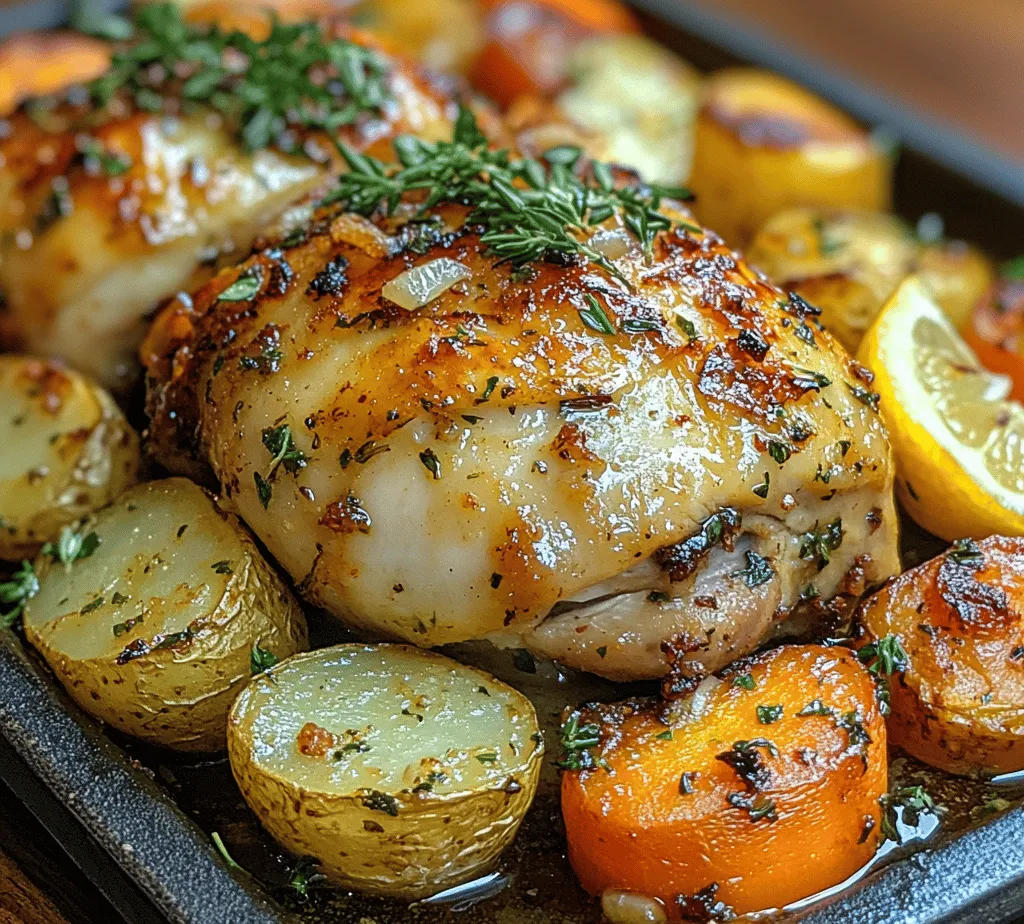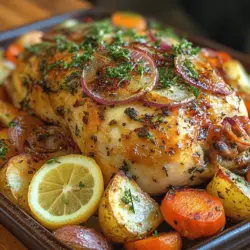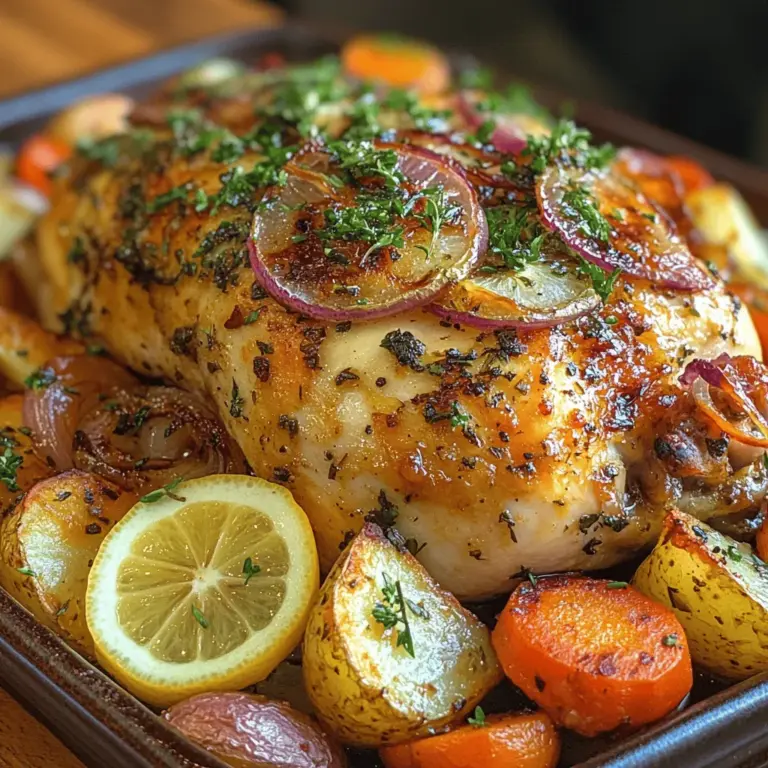Introduction
In the world of home-cooked meals, few dishes evoke warmth and comfort like a perfectly roasted chicken. The Savory Herb Butter Roasted Chicken stands out not only for its tantalizing flavors but also for its ease of preparation. This dish is a testament to the idea that good food doesn’t necessarily need to be complicated; rather, it can be achieved through the thoughtful selection of quality ingredients and the right cooking techniques. As we delve into this delightful recipe, you will discover how each component plays a crucial role in creating a succulent, flavorful chicken that will undoubtedly be the centerpiece of your dining table.
Roasting a chicken is an age-old tradition that brings families together, whether for a casual Sunday dinner or a festive holiday gathering. The enticing aroma of a chicken roasting in the oven can make any house feel like home. This Savory Herb Butter Roasted Chicken recipe incorporates a blend of fresh herbs, zesty lemon, and tender vegetables, elevating the humble chicken to a whole new level of flavor. The combination of herb-infused butter and the natural juices from the chicken creates a delectable dish that is sure to impress your family and guests alike.
Let’s embark on this culinary journey where every step is designed to enhance your cooking experience, leading to a mouthwatering roast that you can proudly serve.
Understanding the Ingredients
Whole Chicken Selection
Choosing the right chicken is fundamental to the success of your dish. When selecting a whole chicken, quality matters significantly. Opt for a bird that is free-range or organic whenever possible. These chickens are often raised in better conditions and fed a healthier diet, resulting in a more flavorful and tender meat.
Size: The size of the chicken should align with the number of people you are serving. A 4-5 pound chicken is usually sufficient for a family meal, providing enough leftovers for sandwiches or salads the next day.
Freshness: To ensure freshness, check the packaging for the sell-by date. A fresh chicken will have a pleasant, mild scent, while any off-putting odor is a sign that it should be avoided. If possible, purchase your chicken from a reputable butcher or farmer’s market where you can inquire about the bird’s source and handling.
The Role of Herb Butter
The herb butter is the star of this recipe, infusing the chicken with rich flavors that penetrate deep into the meat. The combination of fresh herbs adds complexity and depth, transforming a simple roast chicken into an aromatic delight.
Rosemary: Known for its woody fragrance, rosemary complements the savory notes of chicken beautifully. Its pungent flavor pairs well with the richness of the herb butter.
Thyme: Thyme introduces a subtle earthiness to the mix. It is versatile and works harmoniously with other herbs, enhancing the overall flavor profile of the dish.
Sage: Sage brings a slightly peppery taste and a hint of sweetness, which balances the richness of the butter. Its aromatic qualities make it a classic pairing with poultry.
Garlic: Adding minced garlic to the herb butter not only boosts the flavor but also brings a delightful aromatic quality to the dish. Garlic adds a savory punch that elevates the entire meal.
Lemon: The zest and juice of a fresh lemon brighten up the herb butter, providing acidity that cuts through the richness of the chicken and keeps the dish from feeling heavy.
Vegetables That Complement
In addition to the chicken, including vegetables in the roasting pan is an excellent way to enhance both flavor and presentation. Onions, carrots, and potatoes are traditional choices that work wonderfully together.
Onions: Roasting onions brings out their natural sweetness, which caramelizes beautifully during cooking. They also impart flavor to the chicken as it cooks.
Carrots: Carrots add a touch of sweetness and color, making the dish visually appealing. Their texture holds up well during roasting, providing a satisfying bite.
Potatoes: Potatoes serve as a hearty side that absorbs the flavorful juices from the chicken. They become tender and flavorful, soaking up the herb-infused butter and drippings.
Incorporating these vegetables not only enhances the flavor profile but also contributes to a well-rounded meal that requires minimal additional preparation.
Preparation Steps for Success
Preheating the Oven
Before diving into the preparation of your chicken, it’s essential to preheat your oven to the right temperature. Roasting chicken typically requires a temperature of around 425°F (220°C).
Importance of Temperature: Preheating ensures that the chicken cooks evenly and efficiently. A hot oven helps to create crispy, golden-brown skin while keeping the meat juicy and tender inside.
Effect on Cooking Time and Texture: An adequately preheated oven reduces cooking time and significantly improves the texture of the chicken skin. If you place the chicken in a cold oven, it will take longer to cook, leading to uneven results and a less desirable texture.
Crafting the Perfect Herb Butter
The next step in your culinary adventure involves creating the herb butter, which will be the flavor foundation for your roasted chicken. Follow these steps for a perfectly blended herb butter:
1. Ingredients: Start with one cup of unsalted butter, softened to room temperature. Add in a mix of your chosen herbs—about two tablespoons each of fresh rosemary, thyme, and sage, finely chopped.
2. Garlic and Lemon: Incorporate three cloves of minced garlic and the zest of one lemon into the butter mixture. The garlic adds depth, while the lemon zest provides brightness.
3. Mixing: In a mixing bowl, combine the softened butter with the herbs, garlic, and lemon zest. Use a fork or spatula to thoroughly mix until all ingredients are evenly distributed.
4. Seasoning: Add salt and freshly cracked black pepper to taste. This step is crucial, as it enhances the overall flavor of the butter.
5. Making it Spreadable: If the butter is too firm, you can microwave it briefly in short bursts until it achieves a creamy consistency. Be cautious not to melt it completely, as you want to maintain its structure for spreading.
Preparing the Chicken
Once your herb butter is ready, it’s time to prepare the chicken for roasting. Proper preparation is key to achieving a beautifully roasted bird.
1. Patting Dry: Begin by removing the chicken from its packaging and patting it dry with paper towels. This step is essential for achieving crispy skin, as moisture can prevent it from browning properly.
2. Loosening the Skin: Carefully loosen the skin of the chicken breast without tearing it. You can use your fingers to gently separate the skin from the meat. This technique allows the herb butter to penetrate deeper into the chicken, ensuring maximum flavor.
3. Applying the Herb Butter: Take a generous amount of the herb butter and spread it under the skin, directly onto the meat. Be sure to distribute the butter evenly for consistent flavor. Next, rub any remaining butter over the outer surface of the chicken, ensuring every part is coated.
Seasoning Techniques
Seasoning is a crucial step in the roasting process that enhances the chicken’s flavor profile. Here are effective methods to ensure your chicken is well-seasoned:
1. Salt and Pepper: After applying the herb butter, generously season the outside of the chicken with salt and freshly cracked black pepper. This step is vital, as it creates a flavorful crust that adds depth to the dish.
2. Inside the Cavity: Don’t forget to season the cavity of the chicken. Adding salt and pepper inside enhances the overall taste and allows the flavors to permeate the meat as it cooks.
3. Aromatics: For an extra layer of flavor, consider placing aromatics inside the cavity, such as a halved lemon, a few sprigs of fresh herbs, or even garlic cloves. These will infuse the chicken with additional fragrance during roasting.
Enhancing Flavor with Citrus and Aromatics
Citrus not only adds brightness but also enhances the overall flavor profile of your dish.
Impact of Lemon Juice: Squeezing fresh lemon juice over the chicken before roasting can elevate the dish’s acidity, balancing the richness of the herb butter. The acidity helps to tenderize the meat and adds a refreshing note that complements the savory elements beautifully.
Using these preparation steps and understanding the importance of each ingredient will set you on the right path toward creating a delicious Savory Herb Butter Roasted Chicken that will delight your family and friends. The next section will continue with the roasting process and provide tips for achieving the perfect roast.

How Lemon Juice Contributes to Moisture and Flavor
Lemon juice is a key ingredient in the Savory Herb Butter Roasted Chicken recipe, serving multiple purposes that enhance both moisture and flavor. The acidity of lemon juice helps to break down proteins in the chicken, resulting in a more tender and juicy final product. When marinated, lemon juice allows the flavors of the herbs and butter to penetrate deeper into the meat, creating a harmonious blend of tastes.
The science behind citrus in cooking is fascinating. Citrus fruits, such as lemons, contain citric acid, which acts as a natural tenderizer. This acid denatures the proteins in the chicken, making them softer and more palatable. Additionally, lemon juice adds a bright, zesty flavor that balances the richness of the butter and herbs, ensuring that every bite is both savory and refreshing.
Utilizing Aromatics
Incorporating aromatics such as onion into the chicken cavity is another essential step that elevates the flavor profile of the roasted chicken. Onions, when roasted, caramelize and release their natural sugars, adding sweetness and depth to the dish. Placing onion inside the cavity infuses the chicken with its savory essence as it cooks, enhancing the overall taste and aroma.
Aromatics significantly influence the final outcome of the dish. They interact with the meat during the roasting process, creating a complex flavor that can’t be achieved through seasoning alone. Alongside onions, consider adding garlic cloves, fresh herbs like rosemary or thyme, and even citrus slices to the cavity for an extra layer of flavor.
Vegetable Preparation and Roasting
Preparing the Root Vegetables
Root vegetables are perfect companions for roasted chicken, absorbing the drippings and flavors as they cook. When preparing carrots and potatoes, uniform cutting is essential for even cooking. Here’s how to properly prepare them:
1. Carrots: Peel and cut the carrots into even-sized sticks or rounds, about 1-inch thick. This size ensures they cook at the same rate as the potatoes. Toss the carrots in olive oil, salt, and pepper for seasoning.
2. Potatoes: Depending on whether you use baby potatoes or larger ones, cut them into halves or quarters. Baby potatoes can remain whole, while larger potatoes should be cut into pieces similar in size to the carrots. Season them similarly with olive oil, salt, and pepper.
To ensure even cooking, arrange the vegetables in a single layer on the roasting pan, ensuring they are not overcrowded. This allows hot air to circulate freely around them, leading to perfectly roasted, caramelized vegetables.
Roasting the Chicken and Vegetables
Timing and temperature are crucial for achieving optimal results when roasting chicken and vegetables. Preheat your oven to 425°F (220°C) for a robust roast. The high temperature not only helps to brown the skin of the chicken but also caramelizes the vegetables, enhancing their natural sweetness.
Place the chicken in the center of the roasting pan, surrounded by the seasoned root vegetables. Roast for approximately 1 hour and 20 minutes, or until the internal temperature of the chicken reaches 165°F (75°C) at the thickest part of the thigh. Using a meat thermometer is highly recommended for accuracy.
Understanding the internal temperature is essential for safe consumption. Chicken should always be cooked to a minimum internal temperature of 165°F (75°C) to ensure harmful bacteria are eliminated. Allowing the chicken to reach this temperature ensures juicy, flavorful meat without compromising safety.
Resting and Serving the Chicken
Importance of Resting
Once the chicken is roasted to perfection, it’s crucial to let it rest before carving. Resting allows the juices to redistribute throughout the meat, ensuring that each slice remains moist and flavorful. If you cut into the chicken immediately after removing it from the oven, the juices will run out, leaving you with dry meat.
The recommended duration for resting the chicken is about 15 to 20 minutes. Cover the chicken loosely with aluminum foil to keep it warm while it rests. This step is often overlooked, but it can make a significant difference in the final texture and juiciness of your roasted chicken.
Carving and Presentation
Carving the chicken properly is essential for both presentation and serving. Here’s a step-by-step guide to carving your perfectly roasted chicken:
1. Remove the legs: Using a sharp knife, cut through the skin connecting the leg to the body, then gently pull the leg away from the body to expose the joint. Cut through the joint to remove the leg completely. Repeat this process for the other leg.
2. Remove the wings: Similar to the legs, cut through the skin and find the joint to remove the wings from the body.
3. Carve the breast meat: Starting at the top of the breast, slice downwards against the grain in even, thick pieces. Aim for slices about half an inch thick for an appealing presentation.
4. Arrange the pieces: On a serving platter, arrange the carved chicken pieces alongside the roasted vegetables. This not only looks inviting but also showcases the beautiful color and texture of the dish.
For an attractive presentation, consider garnishing the platter with fresh herbs, lemon wedges, or a sprinkle of paprika for color.
Flavor Pairings and Serving Suggestions
Ideal Side Dishes
To complement your Savory Herb Butter Roasted Chicken, consider serving it with ideal side dishes that enhance the meal. Here are some suggestions:
– Garlic Mashed Potatoes: Creamy mashed potatoes infused with garlic provide a comforting side that pairs beautifully with roasted chicken.
– Roasted Brussels Sprouts: Seasoned with balsamic vinegar and olive oil, these sprouts add a delightful crunch and earthy flavor.
– Mixed Green Salad: A fresh salad with seasonal greens, cherry tomatoes, and a light vinaigrette balances the richness of the chicken.
When it comes to beverages, consider serving a crisp white wine, such as Chardonnay or Sauvignon Blanc, which will complement the flavors of the dish without overpowering it. If you prefer non-alcoholic options, sparkling water with a twist of lemon can be a refreshing choice.
Garnishing for Aesthetic Appeal
Garnishes can significantly elevate the presentation of your roasted chicken dish. Here are some ideas for fresh herb garnishes:
– Parsley or Thyme: Chopped fresh parsley or thyme adds a vibrant green touch and enhances the dish’s aroma.
– Lemon Zest: A sprinkle of freshly grated lemon zest can brighten the dish visually and add an extra hint of citrus flavor.
– Edible Flowers: For an elegant touch, consider edible flowers like nasturtiums or pansies, which can add color and sophistication.
Using garnishes not only enhances the visual appeal but also ties in the flavors of the dish, making each element feel cohesive and well-thought-out.
Conclusion
The Savory Herb Butter Roasted Chicken is more than just a meal; it’s a culinary experience that brings family and friends together. Each step, from selecting the right ingredients to the final presentation, plays a crucial role in the outcome of this dish. By following the detailed instructions provided, you can ensure that your roasted chicken is not only flavorful but also visually appealing. This recipe is a testament to the beauty of simple, wholesome ingredients, and with practice, it can become a cherished staple in your cooking repertoire. Enjoy the process, savor the aromas, and relish the delicious results of your efforts.


